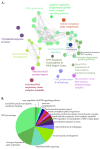Disclosing the Interactome of Leukemogenic NUP98-HOXA9 and SET-NUP214 Fusion Proteins Using a Proteomic Approach
- PMID: 32664447
- PMCID: PMC7407662
- DOI: 10.3390/cells9071666
Disclosing the Interactome of Leukemogenic NUP98-HOXA9 and SET-NUP214 Fusion Proteins Using a Proteomic Approach
Abstract
The interaction of oncogenes with cellular proteins is a major determinant of cellular transformation. The NUP98-HOXA9 and SET-NUP214 chimeras result from recurrent chromosomal translocations in acute leukemia. Functionally, the two fusion proteins inhibit nuclear export and interact with epigenetic regulators. The full interactome of NUP98-HOXA9 and SET-NUP214 is currently unknown. We used proximity-dependent biotin identification (BioID) to study the landscape of the NUP98-HOXA9 and SET-NUP214 environments. Our results suggest that both fusion proteins interact with major regulators of RNA processing, with translation-associated proteins, and that both chimeras perturb the transcriptional program of the tumor suppressor p53. Other cellular processes appear to be distinctively affected by the particular fusion protein. NUP98-HOXA9 likely perturbs Wnt, MAPK, and estrogen receptor (ER) signaling pathways, as well as the cytoskeleton, the latter likely due to its interaction with the nuclear export receptor CRM1. Conversely, mitochondrial proteins and metabolic regulators are significantly overrepresented in the SET-NUP214 proximal interactome. Our study provides new clues on the mechanistic actions of nucleoporin fusion proteins and might be of particular relevance in the search for new druggable targets for the treatment of nucleoporin-related leukemia.
Keywords: BioID; NUP98-HOXA9; SET-NUP214; gene ontology; interactome; leukemia.
Conflict of interest statement
The authors declare no conflict of interest.
Figures






Similar articles
-
Inhibition of CRM1-mediated nuclear export of transcription factors by leukemogenic NUP98 fusion proteins.J Biol Chem. 2010 May 21;285(21):16248-57. doi: 10.1074/jbc.M109.048785. Epub 2010 Mar 16. J Biol Chem. 2010. PMID: 20233715 Free PMC article.
-
CREB binding protein interacts with nucleoporin-specific FG repeats that activate transcription and mediate NUP98-HOXA9 oncogenicity.Mol Cell Biol. 1999 Jan;19(1):764-76. doi: 10.1128/MCB.19.1.764. Mol Cell Biol. 1999. PMID: 9858599 Free PMC article.
-
Chromatin-prebound Crm1 recruits Nup98-HoxA9 fusion to induce aberrant expression of Hox cluster genes.Elife. 2016 Jan 7;5:e09540. doi: 10.7554/eLife.09540. Elife. 2016. PMID: 26740045 Free PMC article.
-
Nucleoporins and nucleocytoplasmic transport in hematologic malignancies.Semin Cancer Biol. 2014 Aug;27:3-10. doi: 10.1016/j.semcancer.2014.02.009. Epub 2014 Mar 18. Semin Cancer Biol. 2014. PMID: 24657637 Review.
-
NUP214 in Leukemia: It's More than Transport.Cells. 2019 Jan 21;8(1):76. doi: 10.3390/cells8010076. Cells. 2019. PMID: 30669574 Free PMC article. Review.
Cited by
-
CircRNA FUT10 regulates the regenerative potential of aged skeletal muscle stem cells by targeting HOXA9.Aging (Albany NY). 2021 Jul 13;13(13):17428-17441. doi: 10.18632/aging.203233. Epub 2021 Jul 13. Aging (Albany NY). 2021. PMID: 34257163 Free PMC article.
-
Modulating biomolecular condensates: a novel approach to drug discovery.Nat Rev Drug Discov. 2022 Nov;21(11):841-862. doi: 10.1038/s41573-022-00505-4. Epub 2022 Aug 16. Nat Rev Drug Discov. 2022. PMID: 35974095 Free PMC article. Review.
-
A genetic screen in Drosophila uncovers the multifaceted properties of the NUP98-HOXA9 oncogene.PLoS Genet. 2021 Aug 12;17(8):e1009730. doi: 10.1371/journal.pgen.1009730. eCollection 2021 Aug. PLoS Genet. 2021. PMID: 34383740 Free PMC article.
-
New Activities of the Nuclear Pore Complexes.Cells. 2021 Aug 18;10(8):2123. doi: 10.3390/cells10082123. Cells. 2021. PMID: 34440892 Free PMC article.
-
An Overview of 10th Anniversary of Cells-Advances in Cell Nuclei: Function, Transport and Receptors.Cells. 2022 Dec 23;12(1):55. doi: 10.3390/cells12010055. Cells. 2022. PMID: 36611849 Free PMC article.
References
-
- Yang J., Lyu X., Zhu X., Meng X.-G., Zuo W., Ai H., Deng M. Chromosome t(7;11)(p15;p15) translocation in acute myeloid leukemia coexisting with multilineage dyspoiesis and mutations in NRAS and WT1: A case report and literature review. Oncol. Lett. 2017;13:3066–3070. doi: 10.3892/ol.2017.5823. - DOI - PMC - PubMed
Publication types
MeSH terms
Substances
LinkOut - more resources
Full Text Sources
Research Materials
Miscellaneous

